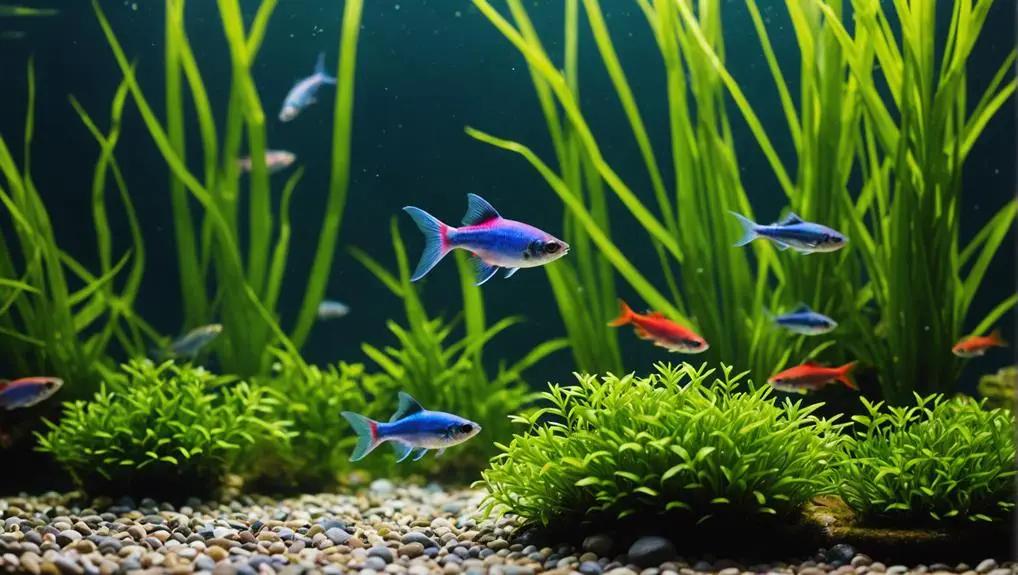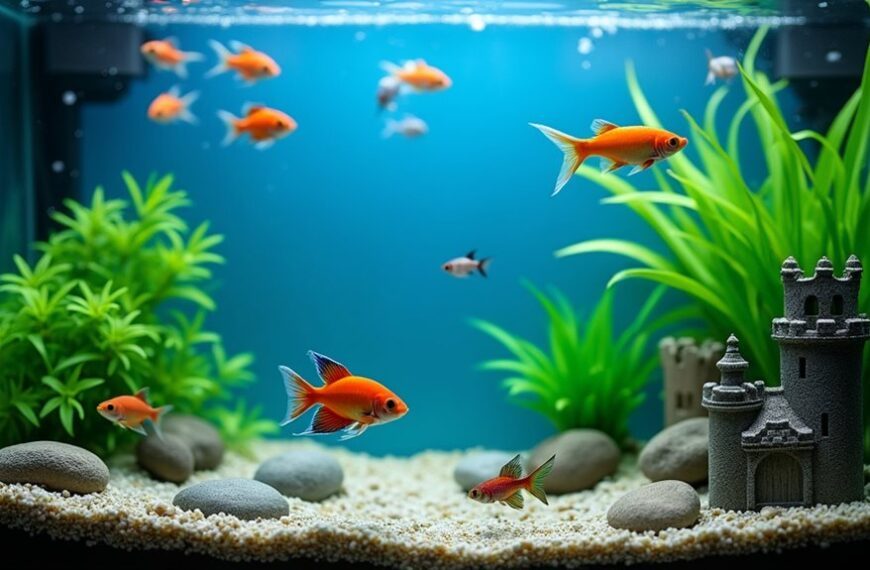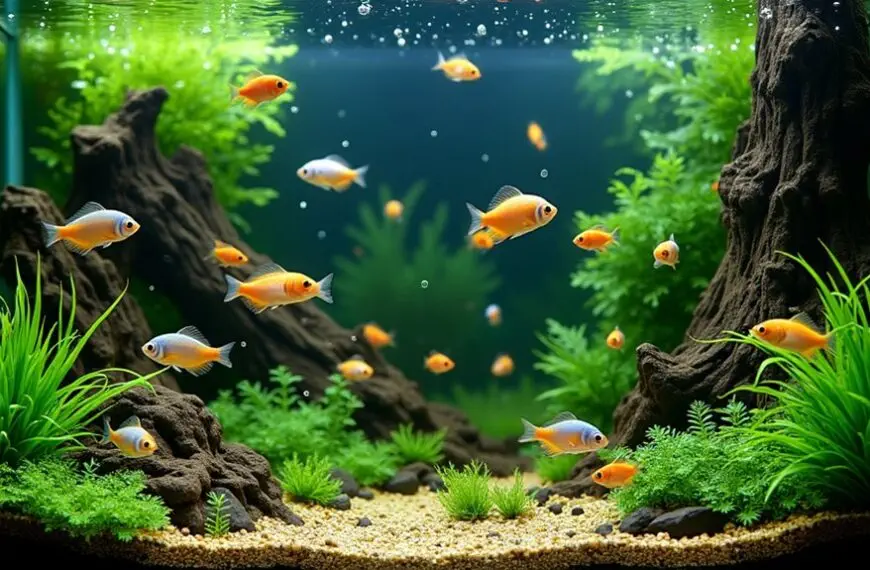If you're starting your aquarium journey, consider low-maintenance fish like goldfish, bettas, and neon tetras. Goldfish are fun but need plenty of space and a clean tank. Bettas add color but prefer solo living, while neon tetras thrive in small schools, making them lively companions. Guppies are charming and breed easily, but be careful with those little fry! Meanwhile, corydoras keep the tank clean as bottom dwellers. If you want more social fish, try zebras or cherry barbs. Each fish has its quirks and needs, so hang tight—there's plenty more to explore about these aquatic buddies!
Contents
Goldfish
When considering a low-maintenance fish for beginners, have you thought about goldfish? These charming swimmers aren't just pretty faces; they're quite adaptable and can thrive in various environments.
However, it's crucial to remember that goldfish can grow up to 12-14 inches long! This means you'll need a minimum tank size of 30 gallons per fish to keep them happy and healthy. Regular water changes are essential to maintain water quality and promote fish health by reducing ammonia levels and harmful contaminants.
As a beginner, you'll appreciate their resilient nature, which makes them easier to care for than some other fish. Just be aware that goldfish produce a fair amount of waste, so pay attention to your water quality. A pelleted diet can also help manage waste and improve water clarity, making your tank a more pleasant place.
While goldfish can sometimes be a bit territorial, it's often best to keep them in a single-species aquarium. This reduces stress and avoids any fishy feuds in your community tank.
With some basic care requirements and a little love, you'll find that goldfish can be a delightful addition to your home!
Betta Fish
When you think about adding a betta fish to your tank, you'll want to keep a few things in mind.
These colorful little guys need at least a 5-gallon tank to really thrive, and you'll need to feed them high-quality pellets to keep them healthy and happy.
Providing proper tank decorations is essential for their well-being, as it enhances their environment and reduces stress by creating hiding spots and structures for exploration safe materials for decorations.
Plus, while male bettas are like the lone wolves of the fish world, some females can hang out together if you plan it just right!
Ideal Tank Size
Creating a comfortable home for your betta fish starts with choosing the right tank size. While a small size might seem appealing, the ideal tank size for bettas is at least 5 gallons. This gives them enough room to swim around and helps maintain stable water conditions, which is crucial for their health.
If you're thinking about keeping them in groups of aquarium, a 10-gallon tank is a good choice. It offers more space and reduces territorial issues, ensuring your bettas feel comfortable.
Betta fish are tropical creatures that thrive in temperatures between 78-82°F, so make sure your freshwater aquarium can maintain that warmth.
Don't forget about filtration! A proper filter with low to medium current keeps the water clean and makes it easy to care for your fish. And remember, bettas love to jump, so a secure lid is essential.
With regular water changes of about 25% each week, your bettas will flourish. By providing the right tank size and environment, you're setting the stage for a happy, healthy betta that's easy to keep and a joy to watch!
Feeding Requirements
To keep your betta fish healthy and vibrant, you need to pay close attention to their feeding requirements.
These little guys have small stomachs, about the size of their eyes, so portion control is key. Stick with high-quality betta pellets designed specifically for their nutritional needs. This won't only keep their colors bright but also boost their energy levels.
Feeding your betta fish 2-3 small meals a day is ideal. Make sure they eat everything within a few minutes to avoid any leftover food that could harm water quality.
Every once in a while, treat them to freeze-dried or live foods like bloodworms or brine shrimp. This adds variety to their diet and taps into their natural hunting instincts—who doesn't love a good chase, right?
Keep an eye on their eating habits.
If you notice any signs of bloating or constipation, it might be time to adjust the type or amount of food you're serving.
With a little care, your betta fish will thrive, bringing color and life to your aquarium!
Compatible Tank Mates
Betta fish can thrive in a community tank if you choose their companions wisely. When selecting tank mates, go for peaceful species like neon tetras and rasboras. These little guys aren't only vibrant but also hardy fish that enjoy schooling, making them perfect companions for your betta. Just remember, they need to be in groups to feel secure!
Corydoras catfish are another fantastic option. As bottom dwellers, they help keep your tank clean while typically coexisting well with bettas, provided there's enough space. Speaking of space, ensure your community tank has a minimum tank size of 10 gallons. This gives everyone room to swim and creates hiding spots for your betta, reducing stress.
Now, avoid long-finned species; bettas might mistake them for rivals and nip at their fins—definitely not a friendly vibe! By carefully selecting compatible tank mates, you're setting the stage for a harmonious underwater world.
Neon Tetras

Wondering what makes neon tetras a fantastic choice for beginner aquarists? These small, vibrant tropical fish bring a splash of color to your aquarium and are perfect for a small tank. Neon tetras typically grow to about 1.5 inches, so they won't take up much space. Plus, their peaceful nature makes them great companions for other community fish, like rasboras and corydoras.
Maintaining optimal water quality is essential for their health, as stable conditions can promote their longevity and reduce stress.
One of the best things about neon tetras is their love for company! They thrive in schools of at least six, which helps reduce stress and encourages their natural social behavior. Keeping a well-planted tank with plenty of hiding spots makes them feel right at home.
You won't have to worry too much about water changes to keep them happy since they've minimal impact on water quality. Just aim for a temperature between 70°F and 81°F, and keep the pH level around 6.0 to 7.0.
Guppies
Guppies are a fantastic choice for anyone just starting out in the fishkeeping world, and they're not just colorful little swimmers!
You'll want to keep an eye on their care requirements, especially since they breed like crazy, and trust me, you don't want to end up with a tank full of tiny fish before you're ready.
Plus, feeding them is a breeze—just mix it up with some flakes and the occasional green treat, and you'll have happy, healthy guppies in no time!
Care Requirements Overview
When it comes to choosing a low-maintenance fish, guppies (Poecilia reticulata) are an excellent option for beginners. These colorful little swimmers aren't only delightful to watch, but they also have relatively simple care requirements.
Here's a quick overview to help you provide the best environment for your guppies:
- Temperature Range: Keep the water between 68-78°F. Guppies like it cozy!
- pH Level: Aim for a pH level of 6.5-8.0. They're pretty adaptable, so this range works well.
- Size & Social Behavior: Guppies grow to about 1 to 2.5 inches and should be kept in groups of at least three. This prevents stress and promotes social behavior, which makes them happier fish!
- Diet & Health: Feed them high-quality flakes and pellets, along with some plant material.
Don't forget about regular water changes of at least 10% per week to keep their environment healthy.
Breeding and Reproduction
If you're considering expanding your aquarium with guppies, understanding their breeding and reproduction can be both exciting and rewarding. Guppies are livebearers, which means they give birth to free-swimming fry instead of laying eggs. A single female can produce 20-50 fry every 4-6 weeks if conditions are just right. Isn't that amazing?
To create a happy breeding environment, aim for a ratio of one male to two or three females. This setup reduces stress on the females and encourages them to thrive. You'll easily spot males thanks to their vibrant colors and smaller size, while females are larger and rounder.
Make sure to provide a well-planted tank with plenty of hiding spots. Fry are small and vulnerable; without shelter, they might become a snack for adult guppies.
Once the fry arrive, you'll want to feed them finely ground food or specialized fry food to ensure proper growth. Watching your guppies breed and raise their young can be a delightful experience.
Just remember, they're low-maintenance fish, but they sure do know how to keep things lively in your tank!
Feeding and Diet Needs
Providing a varied diet is essential for guppies to thrive and display their vibrant colors. These lively little fish need a balanced feeding routine to stay happy and healthy.
You'll want to feed them 2-3 times a day with small amounts to avoid overfeeding. Here's what to include in their diet:
- High-quality flakes or pellets: These should be the base of their diet, providing essential nutrients.
- Live or frozen foods: Treat them to daphnia or brine shrimp occasionally; they'll love the protein boost!
- Vegetable-based options: Add spirulina or blanched peas to promote digestive health. Guppies are omnivorous, after all!
- Monitor feeding: Ensure food particles are gone within a few minutes to maintain water quality; excess food can lead to ammonia spikes.
Corydoras
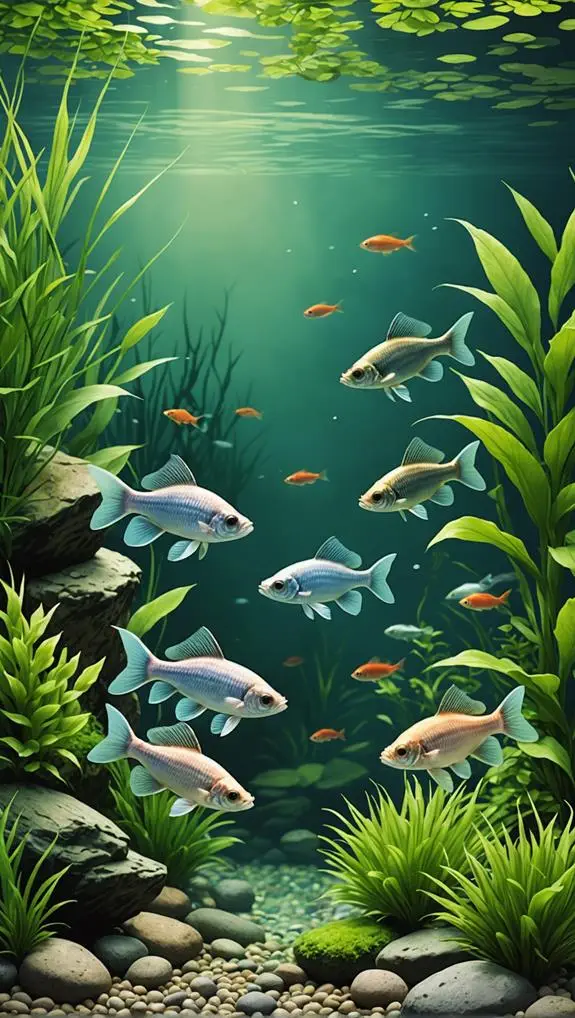
Corydoras, often referred to as cory catfish, are ideal for beginners looking to add low-maintenance fish to their aquariums. These small fish, typically growing to 2-4 inches, are peaceful bottom-dwellers that thrive in groups of at least three to six. Not only do they bring charm to your tank, but they also help keep it clean by scavenging leftover food and detritus.
With over 160 species, including the bronze cory and panda cory, you'll find a variety that suits your taste. They prefer a soft substrate, which protects their delicate barbels while they explore their good home.
As beginner pets, corydoras are adaptable and can thrive in temperatures between 72-82°F and a pH range of 6.5-7.8.
You'll love watching them interact and play, making your aquarium feel alive. Plus, their friendly nature ensures they get along well with other fish in a community tank.
Mollies and Platys
Mollies and platys are vibrant additions to any beginner's aquarium, celebrated for their hardiness and adaptability. These colorful fish can brighten up your tank while being easy to care for. They typically grow to about 3 inches and thrive in various water conditions, making them perfect for new aquarists like you.
Here are a few key points to consider when adding mollies and platys to your aquarium:
- Social Creatures: Both species love to swim in groups. It's best to keep them with multiple females for every male to reduce stress and aggression.
- Omnivorous Diet: They enjoy a mix of flakes, pellets, and even some plants, which makes feeding straightforward.
- Colorful Variety: Mollies come in different color morphs, while platys are known for their stunning patterns, adding visual appeal to your setup.
- Adaptable Nature: They thrive in a pH range of 7.0 to 8.0, so you won't have to worry much about water conditions.
With their friendly demeanor and low-maintenance needs, mollies and platys are fantastic choices for your beginner aquarium!
Zebra Danios
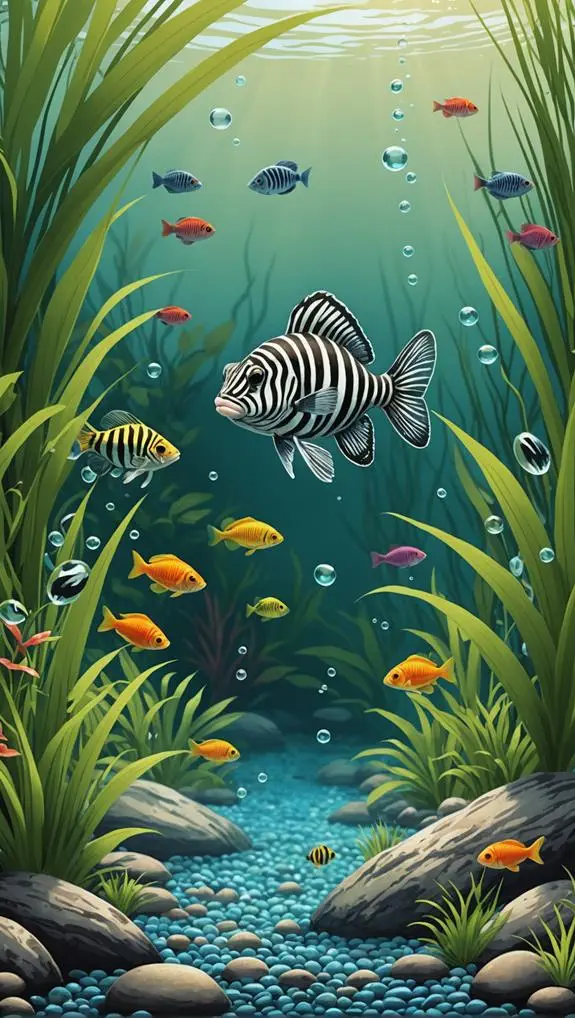
Zebra Danios dart around the aquarium with energy and charm, making them a delightful choice for beginners. If you're looking to create a vibrant community tank, these fish are perfect. They thrive in groups of at least five, so you'll want to gather a lively little school.
With their hardy nature, Zebra Danios are incredibly adaptable, perfect for beginner aquarists who might still be finding their footing. To keep them happy, you'll need a minimum tank size of 10 gallons, allowing your fish plenty of swimming space and hiding spots.
Their energetic nature adds a joyful atmosphere to your aquarium, as they zip around, showing off their playful personality. Plus, they'll thrive on a varied diet, enjoying high-quality flakes, pellets, and the occasional treat of live or frozen foods.
With proper care, you can expect these charming fish to live for about 3 to 5 years. So, if you want to serve up a lively and low-maintenance aquarium, Zebra Danios are just the ticket. Your tank will be buzzing with activity, and you'll love watching them flourish!
Cherry Barbs
Cherry Barbs are a captivating choice for beginner aquarists, thanks to their peaceful nature and vibrant colors. These small fish, reaching about 2 inches, fit perfectly in small to medium community tanks. They thrive when you keep them in groups of at least 5-6 individuals, which not only highlights their social behavior but also helps reduce stress.
Here are some essential tips for keeping cherry barbs:
- Tank Size: A minimum of 10 gallons is ideal for a small group.
- Water Temperature: Maintain a cozy range of 74-80°F for optimal health.
- pH Level: Aim for a pH between 6.0-7.0, giving you a bit of flexibility.
- Community Tanks: They get along well with other peaceful fish, making them perfect for a harmonious setup.
Cherry barbs aren't just eye-catching; they're also incredibly hardy. This makes them an excellent choice for beginners who want to create a stunning aquatic environment without too much fuss.
Harlequin Rasboras
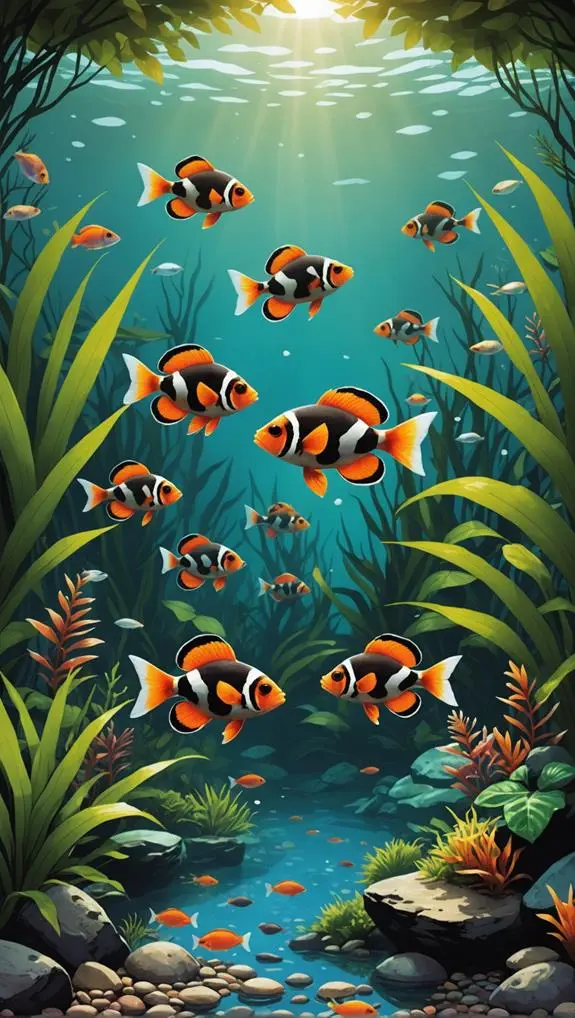
Harlequin rasboras are often regarded as one of the best choices for beginner aquarists due to their peaceful nature and vibrant appearance. These charming little fish, typically growing to about 2 inches, are perfect for community tanks, where they thrive in groups of six or more. Their social behavior not only makes them fun to watch but also helps reduce stress among their tank mates.
To keep your harlequin rasboras happy, set up a well-planted aquarium with subdued lighting. This mimics their natural habitat and enhances their stunning coloration, making your tank a visual delight.
They're adaptable to different water parameters, but they really shine in temperatures ranging from 72°F to 81°F and a pH of 6.0 to 7.5.
What's great about harlequin rasboras is that they're easy to care for, making them a top pick for beginner aquarists. With their hardiness and lively nature, these peaceful schooling fish won't only brighten up your aquarium but also bring joy to anyone who watches them.
Frequently Asked Questions
What Is the Easiest Low Maintenance Fish to Keep?
If you're looking for easy low-maintenance fish, consider Betta Fish or Guppy variety for vibrant colors. Tetra species work well in community tanks, while freshwater shrimp enhance planted tanks, providing compatibility and minimal care requirements.
What Is the Easiest Fish to Catch for Beginners?
When you're learning to fish, focus on local species like guppies or goldfish. Use simple catching techniques, appropriate fishing gear, and best bait. Always check fishing licenses, ideal locations, seasonal fishing, and follow safety tips.
What Is the Best Fish for Beginners to Eat?
When you're diving into cooking, consider sustainable fish like salmon and tilapia. They're nutrient-rich, quick to cook, and offer health benefits. Check local fish markets for price comparisons, ensuring family-friendly recipes are delicious and accessible.
What Is the Easiest Fish Tank to Take Care Of?
For an easy-to-care-for fish tank, focus on betta fish care, choose filtration options wisely, and apply aquascaping tips. Master tank cycling basics, maintain water quality management, and establish feeding schedules for optimal health and disease prevention strategies.
Final Thoughts
So, there you have it! With low-maintenance fish like goldfish and bettas, you can dive into the world of aquariums without feeling like you need a degree in marine biology. Isn't it funny how we often think we need to work hard for things we love? These fish are the perfect reminder that sometimes, the simplest things bring the most joy. Grab a tank, fill it with water, and get ready to enjoy your new underwater buddies!

